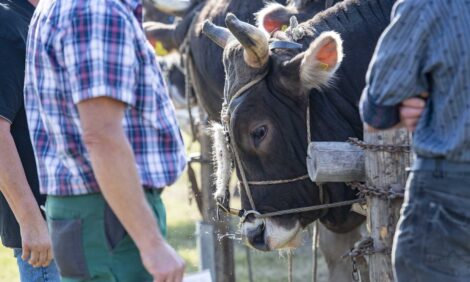



Behavior, physiology, and performance of bulls mixed at the onset of finishing to form uniform body weight groups
By L. Mounier, I. Veissier and A. Boissy, Journal of Animal Science.Abstract
In some production settings, beef bulls are mixed at the beginning of the finishing period to obtain homogeneous groups to facilitate finishing and to produce more homogeneous carcasses. Given the stress induced by mixing, we questioned whether this practice was profitable. Sixty-four young bulls were finished in groups of four over 8 mo. They were either mixed or unmixed and had either homogeneous vs. heterogeneous BW at the beginning of finishing. Behavioral traits (social behavior following mixing and general activities during the finishing period), stress measurements (cortisol concentration, adrenal weight, catecholamine-synthesizing enzyme activity, and pain sensivity), and production traits (growth rate, homogeneity, feed efficiency, and carcass measurements) were evaluated. Bulls reacted to the mixing with increased frequency of social interactions (agonistic interactions: 17.9 in mixed vs. 1.2 in unmixed bulls, P < 0.001; sexual interactions: 9.6 vs. 1.7, P < 0.001; nonagonistic interactions: 5.25 vs. 3.1, P < 0.05). Agonistic and sexual interactions were more frequent between bulls of homogeneous BW (P < 0.05). Throughout the finishing period, the synchronization of activity tended to be lower between mixed bulls (P = 0.09). At slaughter, the activity of tyrosine hydroxylase, a catecholamine-synthesizing enzyme, was increased in mixed bulls (1.52 vs. 1.16 nmol•h–1•mg–1, P < 0.05), which may indicate chronic stress. No differences were noted in ADG or carcass traits among treatments. The variability of BW within groups increased in groups that were initially homogeneous, whereas it decreased in groups that were initially heterogeneous. In conclusion, mixing young beef bulls at the beginning of the finishing period did not have detrimental effects on health and production, but mixing induced stress, perhaps due to decreased cohesion within groups. Thus, we failed to confirm the proposed benefit of mixing bulls to homogenize their BW at the onset of finishing because BW homogeneity within groups was not maintainted throughout the finishing period.Introduction
In some production settings, beef bulls are mixed at the beginning of the finishing period to establish homogeneous BW groups, with the aim of facilitating finishing and producing homogeneous carcasses.In cattle, mixing can promote disease and increase aggression (for reviews, see Bouissou et al., 2001; Boe and Faerevik, 2003), induce stress (Hasegawa et al., 1997; Mench et al., 1990), and affect production traits such as growth (Nakanishi et al., 1993) or milk yield (Hasegawa et al., 1997; Sowerby and Polan, 1978). However, these negative effects seem to be limited to a short period following mixing (Brakel and Leis, 1976; Kondo and Hurnik, 1990).
When mixed animals have similar BW, they usually fight more and for longer periods, especially if feed is not distributed evenly in the environment (pigs; Rushen, 1987). Nevertheless, this does not seem to increase the negative effects of mixing on production (Francis et al., 1996; Hindhede et al., 1999).
The aim of this experiment was to evaluate the effect of mixing on the welfare of finishing bulls and to evaluate if mixing helps to produce homogeneous carcasses. Using a 2 x 2 factorial design, we compared mixed vs. unmixed animals finished in groups of homogeneous or heterogeneous BW. We evaluated behavioral traits (social behavior after mixing, and general activities during the finishing period), stress measurements (cortisol concentration, adrenal weight, catecholamine-synthesizing enzyme activity, and pain sensitivity), and production traits (growth rate, homogeneity of BW, feed efficiency, and carcass measurements). To avoid diseases that could have masked the effects of mixing on stress and behavior, all of the bulls came from the same farm.
To continue reading this article click here .
2005


